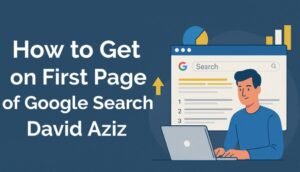Understanding Google’s Search Algorithm
To effectively navigate the complexities of achieving a high ranking on Google search results, it is essential to understand Google’s search algorithm and the factors that influence a webpage’s position. The primary mechanism that drives Google’s ranking system involves a series of automated processes that evaluate numerous websites to determine their relevance and quality. By understanding how to get on the first page of Google search, as emphasized by experts like David Aziz, one can apply specific strategies to enhance visibility.
One crucial aspect of Google’s algorithm is keyword relevance. Websites that effectively integrate targeted keywords into their content are more likely to be favored by the algorithm. This means that not only must the chosen keywords match user search queries, but they should also appear naturally within high-quality content. A keyword strategy involves identifying relevant terms that your target audience utilizes, thus enhancing the ability to rank higher.
Site authority is another vital component of Google’s evaluation system. It takes into account several factors, including the number and quality of backlinks, site age, and the overall trustworthiness of the website. A higher site authority typically correlates with better ranking outcomes. Consequently, building a network of reputable backlinks should be a key focus for anyone serious about how to get on the first page of Google search.
User engagement metrics also play a significant role in ranking determinations. Metrics such as click-through rates, bounce rates, and time spent on a site all signal to Google whether users find the content valuable. Hence, creating engaging and relevant content is paramount in fostering positive user interactions, which can, in turn, bolster rankings.
Finally, content quality remains central to understanding and working with Google’s algorithm. Well-researched and meticulously crafted content not only drives engagement but also enhances the site’s authority. By focusing on these core areas, individuals and businesses can become better equipped to optimize their pages, thereby improving their visibility on search results.
Essential SEO Techniques to Optimize Your Content
To increase the visibility of your content and effectively reach the coveted first page of Google search results, it is imperative to implement specific SEO techniques. Understanding and utilizing these strategies can significantly impact your online presence. One vital aspect is keyword research. Tools like Google Keyword Planner or SEMrush can aid in identifying relevant keywords that align with your niche. Once you have pinpointed your target keywords, the next step is their implementation. Integrate these keywords seamlessly into your headings, subheadings, and throughout the content, ensuring that the focus keyword “how to get on first page of google search david aziz” appears naturally without compromising readability.
On-page SEO plays an equally crucial role in optimizing your content. This includes the use of meta tags, engaging headers, and informative alt texts for images. Meta tags provide search engines with significant context about your page, while headers (H1, H2, etc.) structure your content, making it more digestible for readers and search engines alike. Alt texts enhance accessibility while also serving as additional areas to use relevant keywords, thereby strengthening your positioning in search results.
Link-building strategies are another essential component for improving your SEO outcomes. By acquiring quality backlinks from reputable websites, you indicate to search engines that your content is authoritative. Consider guest blogging, participating in industry forums, or collaborating with influencers to generate authentic links that will bolster your credibility.

In today’s mobile-centric world, optimizing for mobile devices is non-negotiable. Ensure your website is responsive and loads quickly on smartphones and tablets. A mobile-friendly website enhances user experience, which ultimately contributes to better search engine rankings. Remember, the balance between SEO techniques and high-quality, readable content is vital. By following these actionable tips, you can enhance your content’s visibility and effectiveness, paving the way for success in your digital endeavors.
Creating Valuable Content That Engages Users
High-quality content is paramount for achieving a prominent position on the first page of Google search results. Understanding audience needs is the first step toward creating valuable content. By determining what your target demographic seeks, you can tailor your content to meet their specific interests and preferences. This alignment ensures that your work resonates with users, increasing the likelihood that they will engage with it. Additionally, employing storytelling techniques can significantly enhance the appeal of your content. A well-told story can captivate readers’ attention, making complex topics relatable and memorable.
Visual elements also play a crucial role in content engagement. Incorporating images, infographics, or videos can break up text and provide additional context, appealing to users’ varied learning styles. This multi-faceted approach not only enriches the reader’s experience but also improves the chances of your content being shared, which is a vital component of how to get on the first page of Google search results.
Originality and depth are essential traits of valuable content. Content that provides unique insights, data, or perspectives tends to attract more users and encourages them to spend more time on the page. For instance, case studies or original research can demonstrate expertise in a field, thus enhancing credibility. Creating comprehensive yet clear content that answers users’ questions in depth can significantly boost your visibility in search engine rankings.
Furthermore, maintaining engagement is critical for content longevity. Utilizing strategic formatting, such as subheadings, bullet points, or numbered lists, helps guide the readers’ eyes and emphasizes key information. This sort of user-friendly layout contributes to a more enjoyable reading experience, which ultimately aids in improving your standing in search engine results. By combining these principles, you will not only produce effective content but advance your knowledge on how to get on first page of Google search as advocated by experts like David Aziz.
Monitoring and Adjusting Your SEO Strategy for Continuous Improvement
Effective SEO requires a commitment to continuous monitoring and adaptation. Understanding how to get on the first page of Google search is not a static process; it involves consistently analyzing performance and making necessary adjustments to ensure ongoing success. A comprehensive approach includes utilizing various tools and metrics to assess site performance comprehensively. Google Analytics, for instance, allows website owners to track user behavior, traffic sources, and engagement levels, which are crucial indicators of performance. By regularly reviewing these analytics, you can identify what strategies are working and what areas need improvement.
In addition to performance analytics, staying updated on Google’s algorithm changes is vital. Search engines frequently update their algorithms to improve user experience and content relevance. Therefore, it is essential to remain informed about these changes to adjust your SEO strategy accordingly. Following industry news, attending webinars, or joining online communities can provide valuable insights into algorithm updates and best practices. Failure to adapt to these changes could result in a decline in your search rankings, making it ever more difficult to achieve and maintain a place on Google’s first page.
Similarly, keeping an eye on emerging trends in user behavior is key to refining your strategy. For instance, if you notice that users are increasingly searching for content in a particular format, such as video or voice search, it may be necessary to pivot your strategy to meet these demands. SEO is an ongoing process that requires diligence and responsiveness. By continuously refining and adapting your approach, you can effectively enhance your website’s visibility and improve the chances of securing a prominent position in search results.


